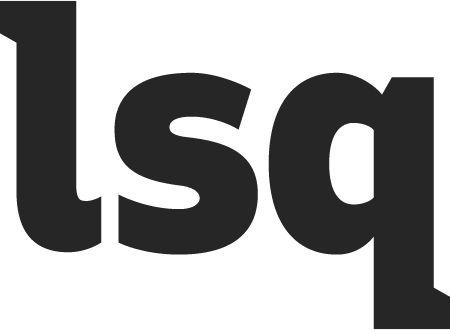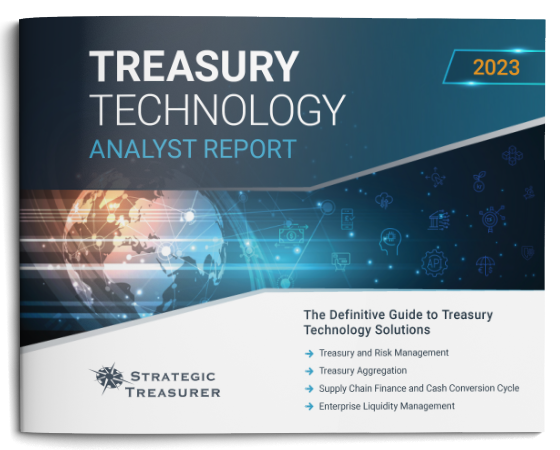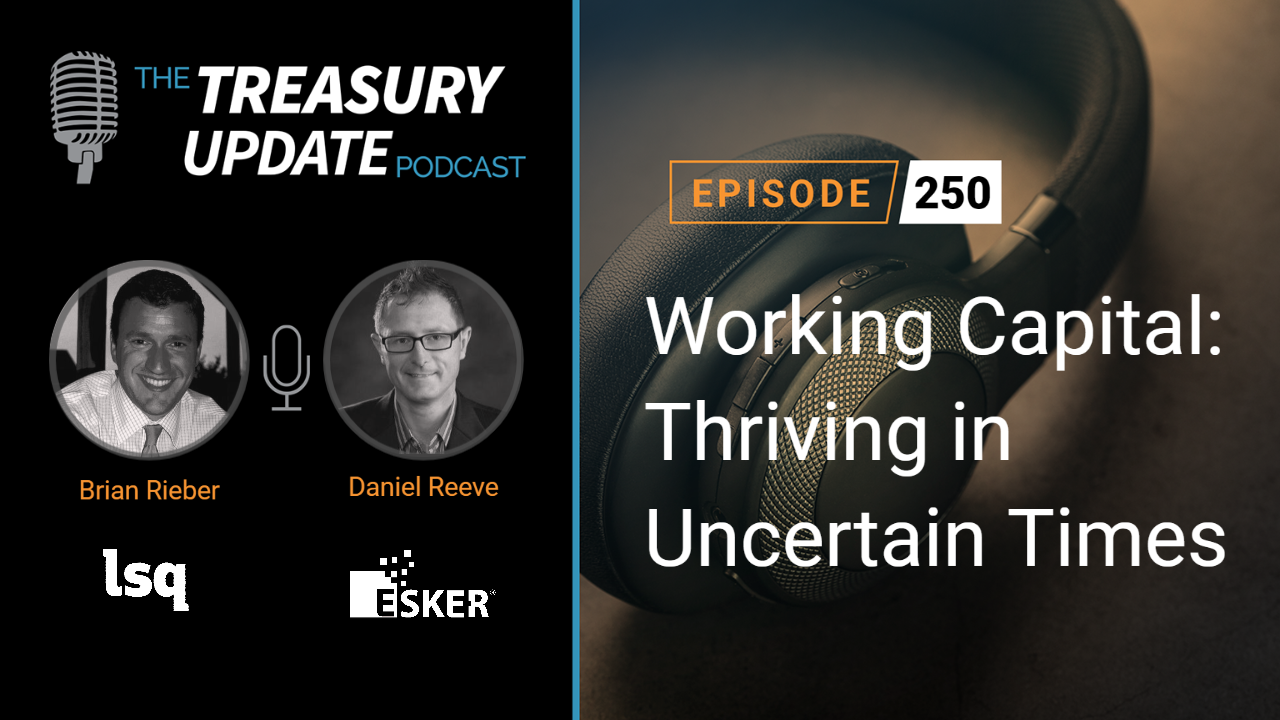
Episode 284
Driving Cost Savings and Improving Liquidity – Tactical Adjustments in the Cash Conversion Cycle with LSQ
In today’s podcast, Craig Jeffery sits down with Vikas Shah from LSQ for a discussion on the pressing need for companies to focus on driving cost savings and improving liquidity. Vikas shares specific examples of how businesses are finding cost savings and adding scalability, along with a look into key market challenges such as increased demand, credit deterioration, and the importance of process efficiency.
Learn more about LSQ here.
Host:
Craig Jeffery, Strategic Treasurer


Speaker:
Vikas Shah, LSQ


Subscribe to the Treasury Update Podcast on your favorite app!
Episode Transcription - Episode #284: Driving Cost Savings and Improving Liquidity–Tactical Adjustments in the Cash Conversion Cycle transcript
Announcer 00:04
Welcome to the Treasury update podcast presented by strategic treasure, your source for interesting treasury news, analysis, and insights in your car, at the gym, or wherever you decide to tune in.
Craig Jeffery 00:18
Welcome to the Treasury Update Podcast. This is Craig Jeffery, your host today. I’m the managing partner Strategic Treasurer. Today’s episode is entitled tactical adjustments in the cash conversion cycle, driving cost savings and improving liquidity. Our guest for today is Vikas Shah from LSQ. Vikas, so good to have you on the podcast, you’ve been strategic matters, but the tactical aspects of our business have come into focus at the latter part of 2023, the tightening of credit, rising prices, they’re all amplifying the focus on cost savings for many companies. The Cash Conversion Cycle is an area of emphasis for driving up costs without losing the ongoing focus on liquidity management. Vikas, as you heard in the intro to the today’s episode, you know, you and I both love to talk about working capital management. In today’s climate, you know, the economic climate, the situation companies are in, I suspect you’re seeing some of the same type of response to the market challenges, there’s a drive to cost savings that now probably equals a focus on working capital management, whereas it used to be almost are very heavily focused on working capital management in the past. What are you seeing?
Vikas Shah 01:31
Craig, first of all, thank you. Thank you for having me, and super excited to be here as part of the podcast. To answer your question, Craig, it actually used to be the opposite, there’s to be a huge focus on cost savings. And working capital wasn’t a top priority for the office of the CFO because, you know, cash was almost free almost 18 months ago. And since the Fed has started increase interest rates, combined with tightening credit combined with higher inflation cost, working capital has become top of mind for the office of the CFO. Now, having said that cost savings continues to be also of equal priority for the office of the CFO. So what’s interesting is that a lot of these corporates are now trying to figure out the right balance between working capital improvement and cost saving levers. And it’s fascinating to see what’s happening in the market right now with, you know, tightening credit, everybody’s trying to hold on to cash as much as possible. All the CFOs are looking for alternative options to make sure that they have ample liquidity available across their lending syndicate. And finally, cost savings continues to be an important lever as well, because a lot of the companies are trying to contain margin. And can you drive that cost savings in today’s market environment, which seems to be quite unpredictable, and volatile? Excellent.
Craig Jeffery 02:51
I know we’ll get into some of the cost savings and the efficiency drivers but maybe for those that are listening to podcasts, it would be great if you could just give us a rundown on what’s your role in LSQ and what what type of problems does LSQ work on solving just by by way of background.
Vikas Shah 03:09
My role at LSQ is all things go to market. I’m responsible for driving sales, business development, marketing and customer success. across our entire customer portfolio. LSQ is a leading industry working capital and payments platform company we help small to midsize businesses mid market and large enterprise customers automate and digitize their AP and AR functions while simultaneously improving cash flow and access to capital for these businesses. You know on the accounts payable side I mean the the typical pain points we often see and we try to solve for our customers dealing with tighter terms with suppliers supply risk is a big topic. Manual and paper check payments is another one unpredictable supplier cash flow needs and a barrage of supplier inquiries. I mean, these are the typical pain points we see on the AP side. On the accounts receivable side. The pain points we tend to tend to see are mainly related to longer collection cycles across the entire customer base. We also see lack of credit management tools to support customer growth or a diversified customer base, delayed cash posting timelines. It takes couple of days for all of these customers to post cash and thereby it impacts their days sales outstanding metric. There is no visibility into the quality of the customers the credit quality of the customers that they’re working with. And then most importantly, there’s lack of access to capital to manage their receivables.
Craig Jeffery 04:41
Those sound like a well balanced set of challenges both capital oriented and efficiency. If we look at some of those examples of cost savings, or that you alluded to or discuss some of the broad categories, where are you finding your clients are most likely to find cost savings is this is finding it through direct reduction of defects, adding scalability, allowing for some type of cost avoidance, instead of hiring someone else, you can handle it by automation. Where are some of these areas for for finding the savings?
Vikas Shah 05:16
Yeah, that’s a great question, Craig. Depending on the size of the company, whether the company is a small to medium sized business, or a mid market or large enterprise company, also, depending on what industry vertical or sector that company is operating under. And then finally, it also depends on the credit quality of the business, which is something that, you know, historically, a lot of a lot of vendors didn’t really talk about that. But in today’s environment, that’s an important vector to really figure out what kind of cost savings the company can potentially drive because it’s usually depend on the credit quality of the customer as well. Some of the examples we’re seeing for cost savings, which are not limited to the this list, but in order of priority are related to, you know, first and foremost, how can a company save interest expense with either reduced or cheaper cost of borrowing? You know, as I mentioned earlier, the cost of borrowing has gone up significantly, for an extremely good quality credit company or investment grade credit, the cost of borrowing is mid single digits. And if if your company is not in that spectrum of credit, then you’re talking about at least single high digits cost of borrowing. So I think that becomes a very expensive line item for most CFOs and treasurer. So that’s, that’s an area of focus for a lot of CFOs. Right now, another area of cost savings opportunities, just automation, efficiency. You know, we’ve seen lots and lots of vendors trying to focus on the Office of the CFO. But there are also lots of options. And it’s really hard for the CFO to kind of figure out where to prioritize which projects to work on. And where can I unlock automation efficiency to drive that cost down. Digitizing payments is another area. Unfortunately, at least in the US, depending on again, on the size of the industry segment, there’s just a lot of payments happening manually, either our check or the process itself is very manual, where there are people involved behind the scenes to send vendor payments, either multiple times a week, or send vendor payments to different business units and such. So that drives a lot of cost for the office of the CFO. And that’s another opportunity supplied and customer customer information management, there aren’t really good systems in place to help these teams manage all of that information. So what ends up happening is that the teams end up spending a lot of manual work in Excel or in other sources to really figure out how to communicate and collaborate with their customers and suppliers. So this tends to be another area of cost savings opportunity. And then finally, this is this is a hidden item that some companies incur and most most vendors are not aware of, which is credit insurance cost. So again, depending on the credit insurance of your counterparty that you’re working with, you’re probably carrying some insurance cost. So you want to be you want to be in a position to really understand the credit quality of your counterparty to try and either avoid that cost or offset that cost. So this is again emerging as another area of cost savings opportunity when it comes to, you know, the broader topic of cost savings and working capital management for a business.
Craig Jeffery 08:30
So the cost of if you had listed these, I think you described it as in the order of priority. Do you see any of these becoming more important, let’s say over the next six months, maybe moving up or any of you expect to move down?
Vikas Shah 08:45
That’s another fantastic question. I would say the focus on cash conversion cycle and any costs related to that is going to be top priority for most CFOs. And I think an immediate second would be most likely automation, efficiency and cost savings thereby. And that could be in the accounts receivable side or accounts payable side or broadly across the office of the CFO. But automation is going to be another hot topic, you know, right after cash conversion cycle.
Craig Jeffery 09:14
It always seems to me that one of the biggest areas for inefficiency is a bad process or a manual process something that’s not automated, something that’s designed poorly it and that leads to defects, someone calling some type of compensating controls and a process to make sure errors aren’t there. If I if we break things up in that category, it seems like several of these items that you list are some of the major subcategories of that but any any thoughts on the the idea that the entire process and automation working together how companies should think about that?
Vikas Shah 09:51
You know, most CFOs and treasurers we’ve talked to I mean, it’s a it’s a fairly daunting task for them. They struggled to kind of figure out where to start, how to prioritize You know, is this going to be a huge lift and change management initiative within the organization. So they’re very reluctant to embark on a holistic project because it can disrupt your day to day operations. The CFO office is also a support function for the entire business. So they don’t want to make sure that the business continues to grow, and continues to operate in a meaningful way. So it’s really hard for the stakeholders within that office to kind of figure out what’s the right priority, and it’s really important for them to understand, first of all, what are the possibilities and even within all these options, you know, there might be some low hanging opportunity for them to prioritize just given lack of bandwidth or lack of expertise within the organization, and partner up with, you know, leading industry experts to potentially pick one or two projects to start showing some, some quick wins. So there are different ways to do this. Certainly, we don’t recommend a big bang approach. But you know, within the HR department or the AP department, I think you can carve out specific areas, or even carve out specific cohorts of either spend, or collections that you can focus on might be a certain region or a business unit. Or it could be a certain spend category, or certain type of customer category, and try to pilot a new process or an automation project within that small cohort and see if you can see some improvements. And if you do through those pilots, then you can keep expanding beyond that. So I think in summary, I would say is that you don’t you don’t have to take a very holistic big bang approach, you can start small, with some pilot, start seeing some quick wins on that variability within the organization drive some immediate cost savings, even though that could be small, but I think think about it as a journey over time on a monthly quarterly basis, as opposed to embarking on a bigger project upfront. Yeah.
Craig Jeffery 11:49
Sounds, sounds good. Maybe little bangs, as opposed to big bang. the overview that you just gave on the different areas is really quite good. And every time I’ve talked to you, you’ve always had examples or case studies, and you tell them in a way of stories, I’d love to dig a little bit deeper, if you have some of those case studies about how companies are driving cost savings in their organizations driving costs out of their organizations, love to hear some of those examples, especially as they’re instructive to other companies that others can learn from that.
Vikas Shah 12:24
Yeah, I’d be happy to it’s all about those stories and nuggets. You know, we have many of them here Adela skew, you know, my first story would be on the accounts receivable side, it’s a story around faster collections and credit management, we have a customer called clone lab. And you know, they they used LSQ’s collection and fed capabilities to to keep them away from actually hiring folks within the credit department and the accounts receivable department. And this is this is really helped clown lab to essentially free up their ER staff to work on more strategic priorities. Another story, which is more on the accounts payable side of our business is helping a company called Rochester i and actually one of the largest suppliers on our platform to automate early payments. And the way Rochester Ryan dealt with this was essentially completely automating and setting their own terms, you know, on the platform. So, so this eliminated a whole lot of manual effort, reconciliation effort around around making sure that the payments actually happen in a very streamlined manner. And no one really had to spend cycles, requesting payments or tracking aging reports and such. So this drove a lot of cost savings for this company as well.
Craig Jeffery 13:36
Without getting too much into the details. How did that work?
Vikas Shah 13:39
Well, the company would essentially use our Fast Track platform, they would essentially go in there and really figure out for a month or for a quarter, you know what, you know, what terms would they like to have, they would be able to calculate the cash flow needs. And the platform would suggest how to set their own terms. And they will be able to set their own terms and just set it and forget it. So they don’t even have to monitor each and every invoice that’s coming do they do not have to monitor their aging reports, all of that is done automatically through the system. And they’re able to solve for the cash flow they need for a given month or for a given quarter. Do you have any other stories? Yeah, we got few more, you know, large specialty chemicals company we’re working with we we help them improve working capital on both both the AR and the AP side. And that led to a massive, you know, interest expense savings for the year. So they’ve been able to rely on that and essentially put that as part of their financial reporting for year end. So it’s been a huge win for this company. Another company we’ve been working with recently that’s a large industrial manufacturer, they have discount payment terms from their suppliers. So the suppliers have actually offered them these discount payment terms. But this company as a buyer have has not been able to leverage these discount payment terms because they don’t want to just deploy their cash To offer the discounts for the supplier. So in this situation we were, we were able to step in and actually help this buyer sees these discount payment terms. And, and really, really help them with the supplier relationship side, providing these discount to the suppliers, and then potentially passing a portion of these discounts back to the buyer. So in the traditional model, you know, the buyer was actually capturing some rebates, they weren’t able to do that, because they didn’t want to use the balance sheet. Now, with help of LSQ, we’ve been able to help them not only maintain those supplier relationships, give those discount to the suppliers, but also potentially capture a portion of the rebates back. So this, this led to a really healthy cost savings margin improvement metric, you know, for the CFO.
Craig Jeffery 15:48
So that’s a pretty interesting example, on the capturing discounts. You know, if someone’s extending discounts to get paid early, there’s always that risk that not enough of their customers are going to pay them early. And so just providing the capital, it certainly meets the the financial needs there. But is there any feedback as to how that supports and helps the relationship between let’s say, your customer, and then the company that needs to get paid.
Vikas Shah 16:18
It’s a huge benefit for both the buyer and the supplier in that in that dynamic, because traditionally, the supplier did offer a discount payment, you know, these, these are terms like 210, net 30, essentially, the supplier is offering the buyer, a 2% discount on the face value of the invoice if the buyer agrees to pay that supplier within 10 days on a net 30 invoice. And there are a lot of these discount payment terms that exist in the industry today. But what’s happened is because the cost of capital has gone up dramatically. The CFO is not able to provide these discount terms to the suppliers because they don’t want to use their own cash. Any partnership that steps into that equation and provides this continued opportunity for the suppliers to take these discounts, and help them with cash flow is a huge win win both for the buyer and supplier.
Craig Jeffery 17:12
These are great examples of a casa. We have time for one more if you have another example.
Vikas Shah 17:18
Yeah, sure, correct. The last example I have is our partnership with infor who is a leader in supplier vendor management solutions and our customer United Legwear, who is a global manufacturer for retail athletic apparel for Puma. And the partnership really expands on this opportunity to enable United Legwear to provide an early payment program to all of their foreign suppliers. And this capability really helped United legwear significantly reduce AP operation cost and, and also reduce the our working capital needs to support the increased demand for supply early payments from all of these foreign suppliers. Now a lot of these suppliers were actually based in Asia facing high cost of capital. So this was a huge win for United Legwear in terms of maintaining the supplier relationships, but most importantly, it drove a lot of AP operational cost benefit for United like why because they were able to expand from the incumbent domestic program that they had with LSQ into into the global supplier base on one unified platform.
Craig Jeffery 18:25
Thanks for all these case studies or stories that you had, we’re going to move on to some final thoughts. So you know, as we talked about some of the general situation, you gave some case studies and we talked about the challenges they have what what guidance or final thoughts would you offer companies as they navigate tighter markets, maybe less access to capital more demands from their, their trading partners and those that face some of these cost saving pressures?
Vikas Shah 18:56
I’d love to summarize the final thoughts maybe in three bullets here, the first one being, you know, evaluate your AR and AP operations, tech stack and all the metrics around it, you’d be surprised that there are lots of low hanging opportunities to save cost and man hours. The second one would be cash is no longer free. With you know, software trending at 5%. Plus, the baseline borrowing cost is now single high digits if you have decent credit, you know, every dollar of cash conversion cycle on your balance sheet can save you valuable interest expense. So consider optimizing AR and AP based working capital sooner rather than later. And also think about it as a journey over time not as a one time shot in the arm because it does take some time and effort to focus on it. But getting started earlier is going to give you a huge leg up in the market especially reasonably competition when it comes to overall working capital improvement. And the final thought would be be proactive to x Blow your credit and lending options, especially with non bank partners to diversify your capital stack. So don’t be overly obsessed around just cost of borrowing because you may be able to get less restrictive terms with another partner for marginally higher cost, but you will save lots of money and provide much needed flexibility and control for your business in the long run.
Craig Jeffery 20:22
Excellent. A lot of good points. I think there’s certainly more we could talk about there. And on this topic, really appreciate your time, Vikas. Thank you so much for joining the Treasury Update Podcast.
Vikas Shah 20:32
This was exciting. Thank you for having me, Craig.
Announcer 20:37
You’ve reached the end of another episode of the Treasury Update Podcast. Be sure to follow Strategic Treasurer on LinkedIn. Just search for Strategic Treasurer. This podcast is provided for informational purposes only, and statements made by Strategic Treasurer LLC on this podcast are not intended as legal, business, consulting, or tax advice. For more information, visit and bookmark StrategicTreasurer.com.
Related Resources
Researching new treasury and finance technology can be overwhelming. Strategic Treasurer has stepped in to help. Explore our definitive guide to the treasury technology landscape and discover detailed, data-based coverage of:
- Treasury & Risk Management Systems
- Treasury Aggregators
- Supply Chain Finance & Cash Conversion Cycle Solutions
- Enterprise Liquidity Management
Learn more about these technologies and evaluate some of the top vendors in each industry.
Nobody wants to miss out on revenue growth. Until recently, it was relatively easy to borrow capital and increase inventory to avoid global supply chain issues, but things have changed. While you may have been able to accurately forecast demand, were you planning for the drastic rise in interest rates that have occurred in recent months? Is your working capital plan adjusting? In this episode, Craig Jeffery, Daniel Reeve, and Brian Rieber get together to discuss the macroeconomic, geopolitical, and trade situations surrounding working capital and the financial levers you should be aware of moving forward.







